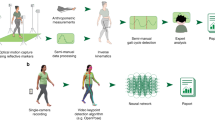Abstract
In this paper, we explore the area of classifying spinal deformities unintrusively using machine learning and RGB cameras. We postulate that any changes to posture due to spinal deformity can induce specific changes in people’s gait. These changes are not limited to the spine’s bending but manifest in the movement of the entire body, including the feet. Thus, spinal deformities such as Kyphosis and Lordosis can be classified much more effectively by observing people’s gait. To test our claim, we present a bidirectional long short-term memory (BiLSTM) based neural network that operates using the key points on the body to classify the deformity. To evaluate the system, we captured a dataset containing 29 people simulating Kyphosis, Lordosis and their normal gait under the supervision of an orthopaedic surgeon using an RGB camera. Results suggest that gait is a better indicator of spinal deformity than spine angle.
Access this chapter
Tax calculation will be finalised at checkout
Purchases are for personal use only
Similar content being viewed by others
References
Ailon, T., Shaffrey, C.I., Lenke, L.G., Harrop, J.S., Smith, J.S.: Progressive spinal kyphosis in the aging population. Neurosurgery. 77(suppl_1), S164–S172 (2015)
Albuquerque, P., Machado, J.P., Verlekar, T.T., Correia, P.L., Soares, L.D.: Remote gait type classification system using markerless 2d video. Diagnostics 11(10), 1824 (2021)
Albuquerque, P., Verlekar, T.T., Correia, P.L., Soares, L.D.: A spatiotemporal deep learning approach for automatic pathological gait classification. Sensors 21(18), 6202 (2021)
Cao, Z., Simon, T., Wei, S.E., Sheikh, Y.: Realtime multi-person 2d pose estimation using part affinity fields. In: Proceedings of the IEEE Conference on Computer Vision and Pattern Recognition, pp. 7291–7299 (2017)
Hochreiter, S., Schmidhuber, J.: Long short-term memory. Neural Comput. 9(8), 1735–1780 (1997)
Jellish, J., et al.: A system for real-time feedback to improve gait and posture in Parkinson’s disease. IEEE J. Biomed. Health Inform. 19(6), 1809–1819 (2015)
Kerrigan, C.K.: Gait analysis in The Science of Rehabilitation, vol. 2. Diane Publishing, Collingdale (2000)
Kozlowski, L.T., Cutting, J.E.: Recognizing the sex of a walker from a dynamic point-light display. Percept. Psychophys. 21(6), 575–580 (1977)
Lee, H.M., Kim, Y.J., Cho, J.B., Jeon, J.Y., Kim, K.G.: Computer-aided diagnosis for determining sagittal spinal curvatures using deep learning and radiography. J. Digital Imaging. 35, 1–14 (2022)
Loureiro, J., Correia, P.L.: Using a skeleton gait energy image for pathological gait classification. In: 2020 15th IEEE International Conference on Automatic Face and Gesture Recognition (FG 2020), pp. 503–507. IEEE (2020)
Makihara, Y., Nixon, M.S., Yagi, Y.: Gait recognition: databases, representations, and applications. Computer Vision: A Reference Guide, pp. 1–13. Springer, Cham (2020). https://doi.org/10.1007/978-3-030-03243-2_883-1
Milne, J., Lauder, I.: Age effects in kyphosis and lordosis in adults. Ann. Hum. Biol. 1(3), 327–337 (1974)
Muro-De-La-Herran, A., Garcia-Zapirain, B., Mendez-Zorrilla, A.: Gait analysis methods: an overview of wearable and non-wearable systems, highlighting clinical applications. Sensors 14(2), 3362–3394 (2014)
Nieto-Hidalgo, M., Ferrández-Pastor, F.J., Valdivieso-Sarabia, R.J., Mora-Pascual, J., García-Chamizo, J.M.: Vision based gait analysis for frontal view gait sequences using RGB camera. In: García, C.R., Caballero-Gil, P., Burmester, M., Quesada-Arencibia, A. (eds.) UCAmI 2016. LNCS, vol. 10069, pp. 26–37. Springer, Cham (2016). https://doi.org/10.1007/978-3-319-48746-5_3
Nieto-Hidalgo, M., García-Chamizo, J.M.: Classification of pathologies using a vision based feature extraction. In: Ochoa, S.F., Singh, P., Bravo, J. (eds.) UCAmI 2017. LNCS, vol. 10586, pp. 265–274. Springer, Cham (2017). https://doi.org/10.1007/978-3-319-67585-5_28
Ortells, J., Herrero-Ezquerro, M.T., Mollineda, R.A.: Vision-based gait impairment analysis for aided diagnosis. Med. Biol. Eng. Comput. 56(9), 1553–1564 (2018). https://doi.org/10.1007/s11517-018-1795-2
Rupprechter, S., et al.: A clinically interpretable computer-vision based method for quantifying gait in Parkinson’s disease. Sensors 21(16), 5437 (2021)
Schuster, M., Paliwal, K.K.: Bidirectional recurrent neural networks. IEEE Trans. Signal Process. 45(11), 2673–2681 (1997)
Simonyan, K., Zisserman, A.: Very deep convolutional networks for large-scale image recognition. ar**v preprint ar**v:1409.1556 (2014)
Slijepcevic, D., et al.: Automatic classification of functional gait disorders. IEEE J. Biomed. Health Inform. 22(5), 1653–1661 (2017)
Troje, N.F.: Decomposing biological motion: a framework for analysis and synthesis of human gait patterns. J. Vis. 2(5), 2 (2002)
Verlekar, T.T., De Vroey, H., Claeys, K., Hallez, H., Soares, L.D., Correia, P.L.: Estimation and validation of temporal gait features using a markerless 2d video system. Comput. Methods Programs Biomed. 175, 45–51 (2019)
Verlekar, T.T., Soares, L.D., Correia, P.L.: Automatic classification of gait impairments using a markerless 2d video-based system. Sensors 18(9), 2743 (2018)
Verlekar, T.T., Correia, P.L., Soares, L.D.: Using transfer learning for classification of gait pathologies. In: 2018 IEEE International Conference on Bioinformatics and Biomedicine (BIBM), pp. 2376–2381. IEEE (2018)
Wahab, Y., Bakar, N.A.: Gait analysis measurement for sport application based on ultrasonic system. In: 2011 IEEE 15th International Symposium on Consumer Electronics (ISCE), pp. 20–24. IEEE (2011)
Wang, K., et al.: Differences between gait on stairs and flat surfaces in relation to fall risk and future falls. IEEE J. Biomed. Health Inform. 21(6), 1479–1486 (2017)
Wang, W., Ackland, D.C., McClelland, J.A., Webster, K.E., Halgamuge, S.: Assessment of gait characteristics in total knee arthroplasty patients using a hierarchical partial least squares method. IEEE J. Biomed. Health Inform. 22(1), 205–214 (2017)
Acknowledgement
We thank the orthopaedic surgeon Dr. Hemant Patil for hel** us construct the spinal deformity dataset.
Author information
Authors and Affiliations
Corresponding author
Editor information
Editors and Affiliations
Rights and permissions
Copyright information
© 2023 The Author(s), under exclusive license to Springer Nature Switzerland AG
About this paper
Cite this paper
Suman, H.K., Verlekar, T.T. (2023). Video-Based Gait Analysis for Spinal Deformity. In: Karlinsky, L., Michaeli, T., Nishino, K. (eds) Computer Vision – ECCV 2022 Workshops. ECCV 2022. Lecture Notes in Computer Science, vol 13805. Springer, Cham. https://doi.org/10.1007/978-3-031-25072-9_18
Download citation
DOI: https://doi.org/10.1007/978-3-031-25072-9_18
Published:
Publisher Name: Springer, Cham
Print ISBN: 978-3-031-25071-2
Online ISBN: 978-3-031-25072-9
eBook Packages: Computer ScienceComputer Science (R0)




